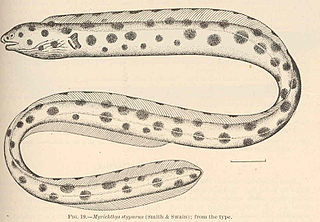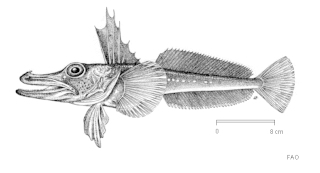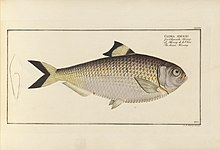
The mottled eel, also known as the African mottled eel, the Indian longfin eel, the Indian mottled eel, the long-finned eel or the river eel, is a demersal, catadromous eel in the family Anguillidae. It was described by John McClelland in 1844. It is a tropical, freshwater eel which is known from East Africa, Bangladesh, Andaman Islands, Mozambique, Malawi, Sri Lanka, Sumatra, and Indonesia and recently from Madagascar. The eels spend most of their lives in freshwater at a depth range of 3–10 metres, but migrate to the Indian Ocean to breed. Males can reach a maximum total length of 121 centimetres and a maximum weight of 7,000 grams. The eels feed primarily off of benthic crustaceans, mollusks, finfish and worms.

The barred moray, also known as the banded moray, the dark-banded eel, the girdled moray, the girdled reef eel, the many banded moray eel, the ringed moray, the ringed reef moray, the striped moray and the zebra eel,) is a moray eel of the family Muraenidae. It was described by John Richardson in 1845, originally under the genus Muraena. It is a marine, tropical eel which is known from the Indo-Pacific, including the Red Sea, East Africa, the Hawaiian Islands, the Marquesan Islands, the Tuamotus Islands, the Ryukyu Islands, and the Great Barrier Reef. It dwells at a depth range of 2 to 20 metres, and leads a benthic lifestyle in reefs and shallow lagoons. Males can reach a maximum total length of 72.3 centimetres (28.5 in). It is sometimes confused with the Zebra moray (Gymnomuraena).

Tenualosa is a genus of ray-finned fish belonging to the family Dorosomatidae, which also includes the gizzard shads and sardinellas. These fishes are found in rivers, brackish waters and coasts in the Indo-Pacific region.
The Highlands long-finned eel is an eel in the family Anguillidae. It was described by Gilbert Percy Whitley in 1938. It is a tropical eel known from freshwaters in eastern New Guinea. The eels spend most of their lives in freshwater but migrate to the ocean to breed. Males can reach a maximum total length of 80 centimetres.
The Polynesian longfinned eel, also known as the Pacific long-finned eel, is an eel in the family Anguillidae. It was described by Johann Jakob Kaup in 1856. It is a tropical eel found in freshwaters in the Pacific, including Sulawesi, Indonesia; the Society Islands, and Pitcairn. The eels spend most of their lives in freshwater, but migrate to the ocean to breed. Males can reach a maximum total length of 100 centimetres, while females can reach a maximum TL of 165 centimetres and a maximum weight of 9,000 grams.

The African longfin eel, also known simply as the longfin eel, is an eel in the family Anguillidae. It was described by Wilhelm Peters in 1852, originally under the genus Muraena. It is a tropical eel known from freshwaters in southern Kenya, Cape Agulhas, Madagascar, and New Caledonia. The eels spend most of their lives in freshwaters far inland, but migrate to the Western Indian Ocean to breed. Males can reach a maximum total length of 150 centimetres; females can reach a maximum standard length of 120 centimetres and a maximum weight of 5,000 grams. The eels can live for about 20 years. Juveniles and adults are known to feed off of carcasses, crabs, and bony fish.
The Pacific shortfinned eel, also known as the Pacific shortfinned freshwater eel, the short-finned eel, and the South Pacific eel, is an eel in the family Anguillidae. It was described by Albert Günther in 1871. It is a tropical, freshwater eel which is known from western New Guinea, Queensland, Australia, the Society Islands, and possibly South Africa. The eels spend most of their lives in freshwater, but migrate to the Pacific Ocean to breed. Males can reach a maximum total length of 110 centimetres, but more commonly reach a TL of around 60 cm. The Pacific shortfinned eel is most similar to Anguilla australis, and Anguilla bicolor, but can be distinguished by the number of vertebrae.

Cynoponticus savanna,, the Guayana pike-conger, pike-headed eel or sapphire eel, is an eel in the family Muraenesocidae. It was described by Edward Nathaniel Bancroft in 1831, originally under the genus Conger. It is a marine, tropical eel which is known from the western Atlantic Ocean, including Central America, the Caribbean and Brazil. It dwells at a maximum depth of 100 metres (330 ft), and inhabits muddy substrates in bays and estuaries. Males can reach a maximum total length of 150 centimetres (59 in), but more commonly reach a TL of 50 centimetres (20 in).
The Finned worm eel is an eel in the family Ophichthidae. It was described by Coenraad Jacob Temminck and Hermann Schlegel in 1846. It is a marine, tropical eel which is known from the Indo-Pacific, including East Africa, the Society Islands, and southern Japan. It is known to dwell in reefs. It is the only worm eel in its region which possesses pectoral fins. Males can reach a maximum total length of 60 centimetres.
Lamnostoma mindora is an eel in the family Ophichthidae. It was described by David Starr Jordan and Robert Earl Richardson in 1908. It is a tropical, freshwater eel which is known from Asia and Oceania, including the Philippines and New Guinea. Males can reach a maximum total length of 40 centimetres (16 in).

The magnificent snake eel, also known as the Hawaiian spotted snake eel, is an eel in the family Ophichthidae. It was described by Charles Conrad Abbott in 1860, originally under the genus Pisodonophis. It is a marine, tropical eel which is known from the eastern central Pacific Ocean, including the Hawaiian Islands, the Leeward Islands, Johnston Island, and Midway Atoll. It dwells at a depth range of 1 to 262 metres, and inhabits crevices, sand and rocks. Males can reach a maximum total length of 78 centimetres (31 in).
The African spoon-nose eel is an eel in the family Ophichthidae. It was described by John Richardson in 1848. It is a tropical, marine eel which is known from the eastern Atlantic Ocean, including Mauritania and Namibia. It is known to dwell at an approximate depth of 40 metres, and inhabits lagoons and coastal waters. It leads a benthic lifestyle, burrowing into sand and mud. Males can reach a maximum total length of 140 centimetres, but more commonly reach a TL of 80 cm.
The ornate snake eel, also known as the sea snake in St. Helena is an eel in the family Ophichthidae. It was described by John Richardson in 1848, originally under the genus Ophisurus. It is a marine, tropical eel which is known from the eastern Atlantic Ocean, including Mauritania, St. Helena, and Ascension Island. It inhabits the continental shelf, where it forms burrows in sand sediments. Males can reach a maximum total length of 90 centimetres (35 in).

The longfin snake-eel is an eel in the family Ophichthidae. It was described by John Richardson in 1848. It has a Dorsal fin beginning above its pectoral fin with a snake-like upper body which is cylindrical, but compressed only along its extreme tail tip. It also has a tubular nostril in front and a nostril along lower edge of the lip in back. Colors range from grey to black to brown. Large longfin snake-eels have wrinkled skin.

The Bean's sawtooth eel is an eel in the family Serrivomeridae. It was described by Theodore Gill and John Adam Ryder in 1883. It is a marine, deep water-dwelling eel which is known from throughout the Atlantic Ocean, the Indian Ocean, and the Western Pacific Ocean, including Iceland, South Africa, Réunion, and Australia. It dwells at a depth range of 0–5,998 metres (0–19,680 ft), and leads a solitary lifestyle. It migrates vertically at night. Males can reach a maximum total length of 78-80 centimetres, making it the largest sawtooth eel.
Procottus jeittelesii, the red sculpin or red Baikal sculpin, is a species of ray-finned fish belonging to the family Cottidae, the typical sculpins. This species is endemic to Lake Baikal in Russia. It is a freshwater fish that dwells under stones or in holes in the mud at a depth range of 0 to 800 m. It is often found at around 100 m (330 ft), and is most abundant during the autumn and winter. From the late winter to the spring it breeds at depths of 5 to 30 m. It can reach a maximum length of 18 cm (7.1 in), but typically is 10–12 cm (3.9–4.7 in). It has a red spotted or banded pattern on a light background. The red sculpin resembles two of its close relatives, the smaller P. gurwici and the larger P. major.
The sturgeon poacher, also known as the sturgeon-like sea-poacher in Canada, is a fish in the family Agonidae. It was described by Wilhelm Gottlieb Tilesius von Tilenau in 1813. It is a marine, temperate water-dwelling fish which is known from the northern Pacific Ocean, including the western Bering Sea, Cape Navarin, the Commander Islands, the Sea of Okhotsk, the Aleutian Islands, and northern California, USA. It dwells at a depth range of 2 to 710 metres, and inhabits soft benthic sediments. Males can reach a maximum total length of 30.5 centimetres (12.0 in).

Girella zebra, also known as zebrafish or stripey bream, is a species of marine ray-finned fish, a sea chub in the family Kyphosidae. It lives in the Indo-Pacific, where it is endemic to the coastal waters of the southern parts of Australia.

Channichthys rhinoceratus, the unicorn icefish, is a species of marine ray-finned fish belonging to the family Channichthyidae, the crocodile icefishes. It is endemic to the Kerguelen-Heard Plateau in the Southern Ocean. It is a demersal species living from surface waters to depths up to 750 m (2,460 ft). It is considered by some researchers as the only species in the genus Channichthys.
Tenualosa macrura, also known as the longtail shad, is a species of fish in the family Dorosomatidae.










